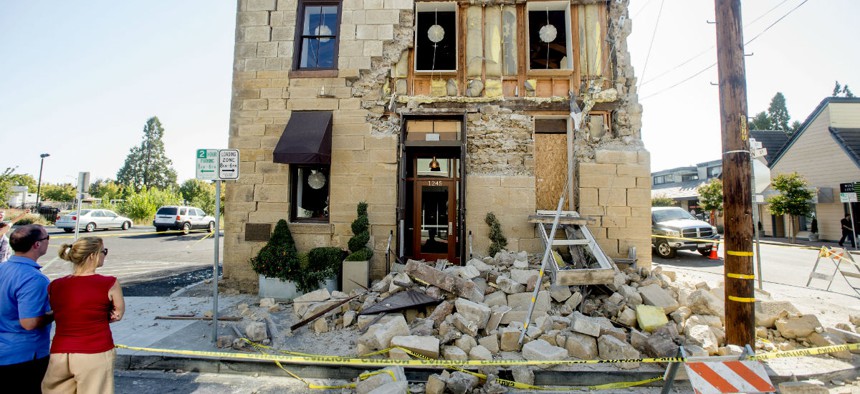How the USGS Detects Earthquakes Using Twitter

Pedestrians examine a crumbling facade following an earthquake in Napa, California. Noah Berger/AP File Photo
And learned to separate background noise from the “wow, that was an earthquake!” tweet.
The world is covered in sensors. Thermometers, barometers, seismometers. When joined together, they have incredible capabilities: Through its global network of seismographs, the United States Geological Service detects earthquakes as they happen, estimates their reach and destruction, and can even warn civilian authorities of what might be on the way.
As the historian Paul N. Edwards details in his book A Vast Machine, the global scientific-sensor network for weather alone took more than a century to build, the culmination of political, economic, and scientific human collaboration.
But the network’s Earth-spanning nature doesn’t mean there are sensors everywhere. There’s a lot of places, still, where the USGS especially doesn’t have seismographs, and where it can fail to detect earthquakes as quickly as it would like. So, to state things somewhat cynically, it’s turned to a new kind of networked sensor of local experience: humans.
According to a Twitter blog post on Wednesday, the USGS has begun to augment its seismological data with a real-time feed of tweets. The social-network data helps fill in holes in the agency’s sensor network and check for false alarms. (The seismic network senses as many as 70 earthquakes per day, but many of them are not felt by anyone at ground-level.)
Twitter confirmation of an earthquake can often come very fast, especially in technology-dense areas. When a magnitude-6.0 quake hit Napa, California, in August 2014, the USGS’s scripts confirmed the quake was real less than 90 seconds after it began. It of course helps that Twitter use is common in northern California—but then again, so are earthquakes.
When combing Twitter for earthquake news, the agency’s scripts look for people writing short. At first, the USGS just searched for people tweeting “earthquake,” which gave them a useful if very noisy feed. Then they started to hone their search, according to Twitter’s blog post: They found that people posting that they had just experienced an earthquake tended to keep their tweets brief. Also, if someone included numbers or a link in their tweet, that tended to mean they were far away from the quake—distant enough to tweet an earthquake event in comfortable detail.
The kind of tweets that the USGS pulls in, in other words, look like this:
Just felt an earthquake here in Napa.
— David Biggar (@DavidNBCLA) April 4, 2014And not like this, for instance, from Atlantic contributing editor Alexis Madrigal:
Man, 6.0 earthquake up in Napa. Certainly felt legit here in Oakland. http://t.co/rVO4pltH9q
— Alexis C. Madrigal (@alexismadrigal) August 24, 2014For comparison, 90 seconds is an extremely fast notification for an earthquake. While the government and a consortium of West Coast universities operate an early-warning system that functions very well—for the 2014 Napa quake, it correctly warned lab technicians in Berkeley 10 seconds before shaking began—it needs more funding before it can be implemented en masse. Until then, existing systems work at about the same speed as Twitter. When a 4.4-magnitude earthquake hit Los Angeles in March 2014, the USGS did not issue an alert until 90 seconds after the tremor began (though, again, the beta early-warning system knew what was happening much earlier). And the Los Angeles Times, which operates an algorithmic earthquake-story-writing program, did not post a story until eight minutes afterward.
I’ve reached out to the USGS to confirm their interest in Twitter but haven’t heard back yet.



